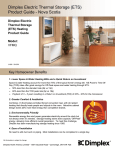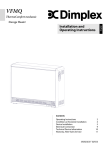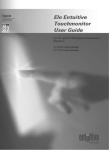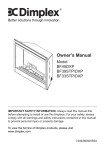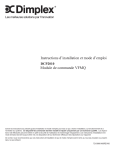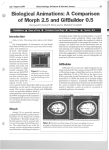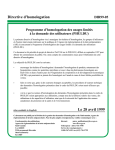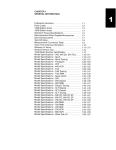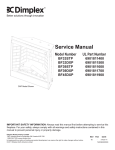Download Dimplex VFMQ 30 Specifications
Transcript
VFMQ Electric Thermal Storage (ETS) Heater Control Options and Wiring Manual Off-Peak Timing Control Options / Automatic vs Manual Charge Control 2 Automatic Charge Control Wiring / DCP2010 Charge Control Panel 3 Wiring the TS521W Wall Thermostat / VFMQ Control and Power Wiring 4 Wiring the RTEV99 Internal Thermostat 5 Manual Charge Control Options 6 Wiring to a Utility-Supplied Contactor 7 Wiring to a Utility-Supplied LV Dry Contact 8 Wiring to a Timer 9 DCP2010 Control Settings Rural Electric Cooperatives Appendix A DCP2010 Control Settings Nova Scotia Appendix B IMPORTANT SAFETY INFORMATION: Always read the installation manuals first before attempting to install or use VFMQ storage heaters or DCP2010 charge control panels. For your safety, always comply with all warnings and safety instructions contained in these manuals to prevent personal injury or property damage. To view the full line of Dimplex products, please visit www.dimplex.com 7211270100 Rev03 VFMQ Storage Heater Off-Peak Timing Control Options VFMQ storage heaters are designed to store heat during the Off-Peak period when electricity is less expensive. The accuracy of the timing controls is critical to cost effective operation. PLEASE NOTE. Different electric utilities use various control methodologies. Please contact your electric utility to understand their Off-Peak control procedure and if they offer an Off-Peak timing device. The most common alternatives: • A utility-supplied control relay. Popular with Rural Electric Cooperatives. • A utility-supplied dry contact on a meter. Standard for Nova Scotia. • A timer. Standard in Ontario. Automatic vs Manual Charge Control Managing the amount of energy to store to meet the next day’s heating requirements can be done automatically or manually. 1. Automatic Charge Control requires the Dimplex DCP2010 Charge Control Panel to estimate how much heat to store to meet the next day’s heating needs. It does this by using advanced algorithms based on temperature data and user preferences. Automatic charge control is better: • for sites with more than one heater. • when low user involvement is desired. • to individually control up to 4 additional circuit loads such as your water heater, baseboard heaters in non-living areas or any other loads on their own circuit up to 30 Amps. • at reducing the sizing of the storage heater in areas that offer mid-peak periods, due to its intelligence for minimizing the use of more-expensive mid-peak power for the coldest days. 2. Manual Charge Control allows the user to decide how much heat to store for the next day by adjusting a knob on the side of the storage heater and: • is less expensive, eliminating the need for the DCP2010 Charge Control Panel. • is recommended for single heater installations. • can be upgraded to use the DCP2010 automatic charge control system at a later time. 7211270100 Rev03 2 Automatic Charge Control Wiring DCP2010 Charge Control Panel Dimplex’s DCP2010 Automatic Charge Control Panel provides the intelligence for the system and: • can control up to 30 VFMQ storage heaters. • can control up to 4 additional 30 Amp loads including the existing water heater, baseboard heaters in non-living areas and any other loads on their own circuit. • the panel is supplied with an external temperature sensor with a 2m (6.5 ft) connection cable that can be extended to 30m (98 ft) by #16/2 wire. • the external sensor allows the DCP2010 controller to automatically correct for the large temperature fluctuations in spring and fall by external temperature averaging. The following wiring diagram shows how the DCP2010 Charge Control Panel connects: • to various Off-Peak control timing devices. • up to 30 VFMQ storage heaters through the Z1, Z2 terminals, wired in parallel. • Up to 4 auxiliary loads such as a water heater. 7211270100 Rev03 3 Wiring the TS521W Wall Thermostat When wiring to the Dimplex TS521W wall thermostat, two additional fuses (F1 & F2) are required to protect the external wiring with a minimum rating of 240 volts and 15 Amps. • The fuses must be wired in-line from terminals 1 & 5 with fully-rated wire (#8 or #10). The stat can then be wired with #12 or #14 from the fuse block. • The 2 x fuse blocks can be installed within the VFMQ storage heater near the terminal blocks. Readily available components: • 2 x Littelfuse #LFR250301S fuse blocks that can connect #8 - #14 gauge wire. • 2 x Littelfuse #FLNR-015 fuses. VFMQ Control and Power Wiring Ground Note. Installation must be in accordance of the wiring codes for load sizing of the circuits and wiring. 7211270100 Rev03 4 Wiring the RTEV99 Internal Thermostat As per the RTEV99 Instructions, fasten the sensor probe assembly by the supplied screws on the base next to the fan. There are four wires: • The white wire marked LE is wired into lower terminal block #7. • The white wire marked LH is wired into lower terminal block #10. • The two wires crimped together are wired to the lower terminal block #8 and jumpered to the upper terminal block #5 / N. • The brown wire marked L is pre-wired to a 2-pole terminal block at #12. This terminal block is to be connected to the pre-drilled holes under the main terminal block and then wired to upper terminal block #2 – L1 to complete the circuit. Wiring by installer - - - - Pre Wired 7211270100 Rev03 5 VFMQ Manual Charge Control Option To reduce the installation cost in homes that require only a single storage heater, the heater’s heat storage charging can be controlled manually eliminating the need for the DCP2010 automatic charge control panel. Every Dimplex storage heater has manual charge control functionality built in. This manual charge control option allows the homeowner to manually decide how much heat energy to store during the next Off-Peak period. No charge is the zero setting (▼), while a full charge for those coldest days (January and February) would be a three (III). The typical winter setting is 2 (II), spring and fall is typically set at 1. Note: The photo on the left shows the manual charge control knob on top. The middle switches and the second knob in the photo are part of the RTEV99 internal thermostat option. Wiring Specifications to Connect various Timing Devices Using the Manual Charge Control Option Connecting to Various Timing Devices: Option 1. The most common method is directly via a utility-supplied contactor. Option 2. A utility-supplied low voltage dry contact in which a voltage needs to be provided to open and close contacts. This method is common in Nova Scotia, Canada. Option 3. A timer. 7211270100 Rev03 6 Option 1. Typical Control Wiring Solution with a Contactor in a Utility-Supplied Device Note: • Use a “normally open” contact if the Utility signal is an open contact for the Off-Peak periods. (Shown) • Use a “normally closed” contact if the Utility signal is a closed contact for Off-Peak periods. (Not Shown) 7211270100 Rev03 7 Option 2. Control Wiring Solution using a Low Voltage Dry Contact from a Utility-Supplied Device • • This method requires low voltage to be passed across a Utility-supplied contact. Used by Nova Scotia Power, the dry contact is part of their Time-Of-Day meter. The transformer is only needed to provide low voltage to the dry contact. Examples of components: • Marcus 12/240 to 12/24 AC transformer - MRCMO50A. • Schneider relay - TLPRPM21B7 and Schneider relay base - TLPRPZF2. • Use a “normally open” contact if the Utility signal is an open contact for Off-Peak periods. (Shown) This is the standard in Nova Scotia and requires the NSPi meter lead wire #113397 to connect to the NSPi meter dry contact. • Use a “normally closed” contact if the Utility signal is a closed contact for Off-Peak periods. (Not Shown) • The suggested transformer and relay panel dimensions are 8” w x 8” h x 4” d. 7211270100 Rev03 8 Option 3 – Control Wiring Solution using a Timer • • • • • Used in lieu of a utility-supplied timing device. An example is Ontario where the Smart Meters do not include physical contacts to synchronize the system to. This solution requires an accurate timer programmed with the Utility's Off-Peak schedule. An example is the Intermatic ET1725C with 7 day programmability, battery backup and changes automatically for daylight savings time. The timing device must be rated for switching 240 volts. In this application, the storage heater will charge when the timer is in “off mode”. The timer must open the control circuit during Off-Peak periods and close for Peak periods. 7211270100 Rev03 9 Dimplex North America Limited 1367 Industrial Road Cambridge, Ontario Canada N1R 7G8 www.dimplex.com For more information, please contact: Brian Reid, Solutions Manager (519) 650-3630 x339 [email protected] 7211270100 Rev03 10 DCP2010 Control Settings - Rural Electric Cooperatives This is a simplified document for trained contractors. For complete instructions, please refer to the DCP2010 Installation and Operating Instructions a) Setting the DIP Switches. The DIP switches are located on the PCB board within the enclosure. Position Set Switch 8 OFF Description Rate Signaling, Closed contact for Off-Peak WARNING: Ensure all circuits are deenergized before opening control enclosure as there may be up to five live circuits NOTE: this DIP Switch must be changed to “ON” if the Utility uses an open contact for Off-Peak times b) Setting the Charge Controller – Operator Mode. Installer to set. Uhr: Enter Set Points Ja, set time TAE: Day ANZ AU Selection Timer (Ja =YES) Set time based on a 24h-Clock Setting the day: T1=Monday, T2=Tuesday, T3=Wednesday, T4=Thursday, T5=Friday, T6=Saturday, T7=Sunday Real-Time display c) Setting the Charge Controller – Technician Mode To set in Technician mode, press the black button as shown on the right. The red LED will illuminate. In Technician Mode, installers must set the following based on the length of the Utility’s Off-Peak period. Selection E1 E3 TU: SEH • • • 8hr (Off-Peak) Enter Set Points -24 7h 9h 0h 10hr (Off-Peak) Enter Set Points -24 9h 11h 0h 12hr (Off-Peak) Enter Set Points -24 11h 13h 0h Description Full charge setting Main charge duration All other settings to be left at factory defaults. After these selections, press button to de-select Technician Mode. Red LED will turn off. If Mid-Peak rates are available, please contract Dimplex @ 1-800-668-6663 x339. NOTE. Installer to fill out the following commissioning table and leave with the homeowner for their records. DCP2010 Control Settings – Rural Electric Cooperatives Appendix A Customer Name: ________________________ Installation Company: _____________________ Address: _______________________________ Installer Phone #: ________________________ _______________________________ Date___________________________________ Set switch to: 8 Off Technician Menu Operator Menu Position Description Enter Setting Rate Signaling (Closed contact for Off-Peak, this DIP Switch must be changed to “ON” if the Utility uses an open contact for Off-Peak times Operator menu abbreviation Operator menu designation Operator menu factory default Enter Setting: LA Runtime 0h 0h E5 Charge level 0% 0% E2 Charge start 15° C 15° C E15 Base charge start 15 % 15 % E10 Additional charging 85 % 85 % ATW Effective external temperature External temperature display Timer Real-time timer No TAE Day setting T1 ANZ Display Enter Setting: Technician menu abbreviation Technician menu designation Technician menu factory setting E1 Full charge - 12° C E3 Main charging duration 7h E4 Minimum charging base 25 % 25% TAS Daytime skip E1 E1 TU Daytime switching 10 h SEH Lock 6h UMD Circulation period 22 h 22 h ATM External temperature averaging Yes Yes FSU Release synchronization with timer No No LFS Earliest start of release 23:00 23:00 LFD Maximum duration of release 8h 8h LZS Earliest start of additional release 14:00 14:00 LZD Maximum additional release duration 0h 0h SHT Daytime heating contactor activation No DCP2010 Control Settings – Rural Electric Cooperatives No Appendix A DCP2010 Control Settings - Nova Scotia This is a simplified document for trained contractors. For complete instructions, please refer to the DCP2010 Installation and Operating Instructions a) Setting the DIP Switches. The DIP switches are located on the PCB board within the enclosure. Position Set Switch Description 1 2 3 4 5 6 7 8 Off Off On On On Off Off On Mid-Peak Off-Set (in hours): 5 hours (the time from the end of Off-Peak to the start of the Mid-Peak) b) WARNING: Ensure all circuits are de-energized before opening control enclosure as there may be up to five live circuits Mid-Peak Duration (in hours ): 4 hours Stepped delay 5 minutes in sequence Rate Signaling Open contact for Off-Peak Setting the Charge Controller – Operator Mode. Installer to set. Selection Uhr: Enter Set Points Ja, set time TAE: Day ANZ AU Timer (Ja =YES) Set time based on a 24h-Clock Setting the day: T1=Monday, T2=Tuesday, T3=Wednesday, T4=Thursday, T5=Friday, T6=Saturday, T7=Sunday Real-Time display c) Setting the Charge Controller – Technician Mode. To set in Technician mode, press the black button as shown on the right. The red LED will illuminate. In Technician Mode, contractors must set the following: Selection E1 TU: SEH FSU LFS LZS LZD • • • Enter Set Points See Table B 9 hr 0 hr Ja 23:00 12:00 4hr Description Table B - Area E1 Setting Real Clock Timer Start of Off-Peak period Start of Mid-Peak period Length of Mid-Peak period Amherst Halifax Kentville New Glasgow Sydney Truro Yarmouth -7 -4 -5 -7 -4 -7 -2 All other settings to be left at factory defaults. After these selections, press button to de-select Technician Mode. Red LED will turn off. Note. E1 is typically set to the outdoor design temperature (°C) for 8+0, but as we’re using the Mid-Peak (8+4), E1 is reduced to minimize the use of more expensive Mid-Peak energy. NOTE. Installer to fill out the following commissioning table and leave with the homeowner for their records. DCP2010 Control Settings – Nova Scotia Appendix B Customer Name: __________________________ Installation Company: _____________________ Address: ________________________________ Installer Phone # ________________________ ________________________________ Date: __________________________________ Set switch Off Off On On On Off 7 Off Stepped delay 5 minutes in sequence 8 On Rate Signaling, Open contact for Off-Peak Technician Menu Operator Menu Position 1 2 3 4 5 6 Description Enter Setting Mid-Peak Off-Set (in hours) 5 hours (the time from the end of off-peak to the start of mid-peak) Mid-Peak Duration (in hours ) 4 hours Operator menu abbreviation Operator menu designation Operator menu factory default Enter Setting: LA Runtime 0h 0h E5 Charge level 0% 0% E2 Charge start 15° C 15° C E15 Base charge start 15 % 15 % E10 Additional charging 85 % 85 % ATW Effective external temperature External temperature display Timer Real-time timer No TAE Day setting T1 ANZ Display Technician menu abbreviation Technician menu designation Technician menu factory setting E1 Full charge - 12° C E3 Main charging duration 7h 7h E4 Minimum charging base 25 % 25% TAS Daytime skip E1 E1 TU Daytime switching 10 h SEH Lock 6h UMD Circulation period 22 h 22h ATM External temperature averaging Yes Yes FSU Release synchronization with timer No LFS Earliest start of release 21:00 LFD Maximum duration of release 8h LZS Earliest start of additional release 14:00 LZD Maximum additional release duration 0h SHT Daytime heating contactor activation No DCP2010 Control Settings – Nova Scotia Enter Setting: 8h No Appendix B














